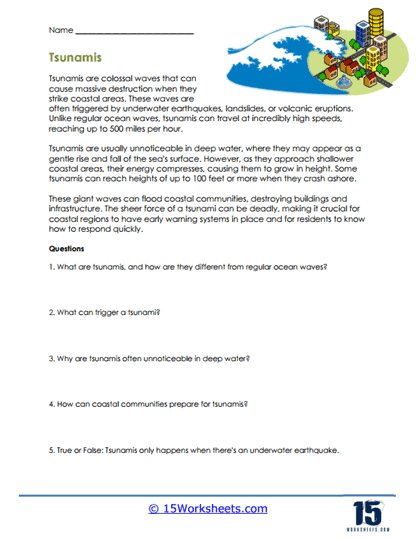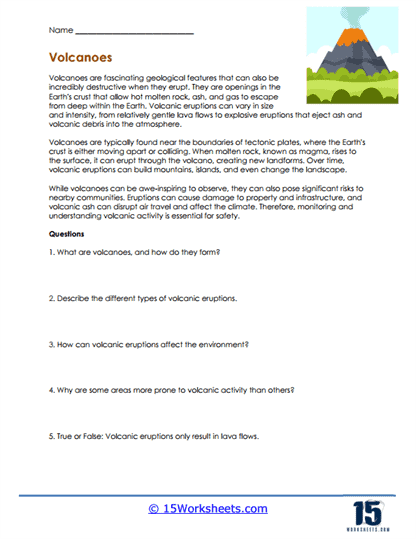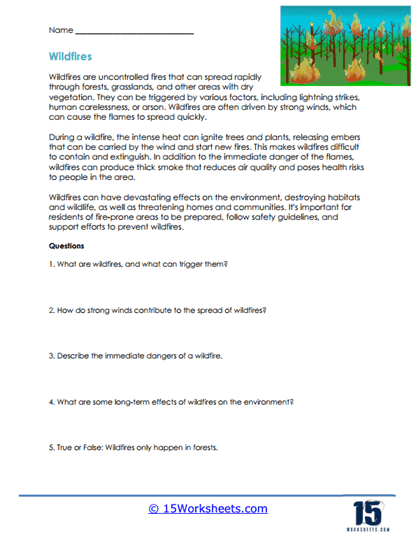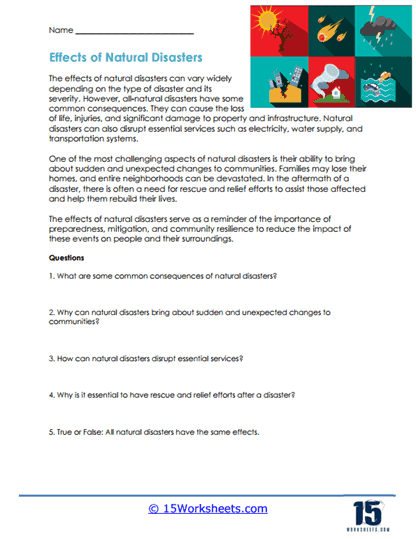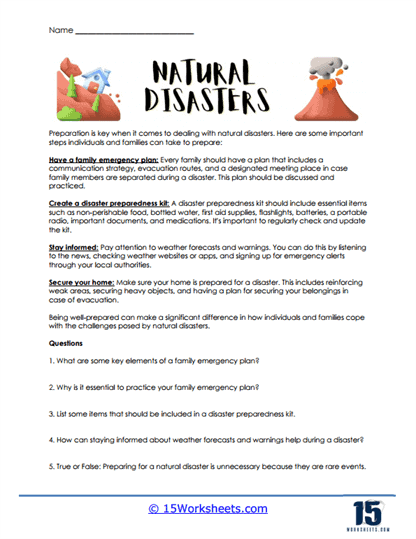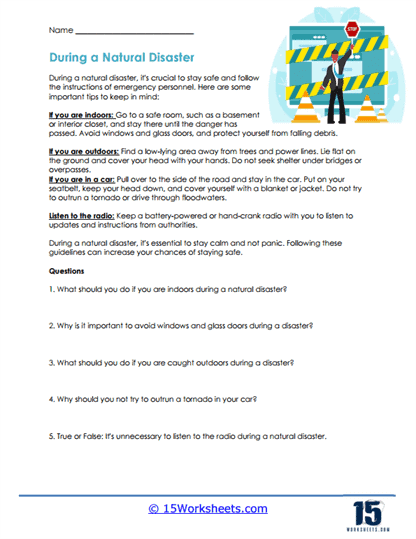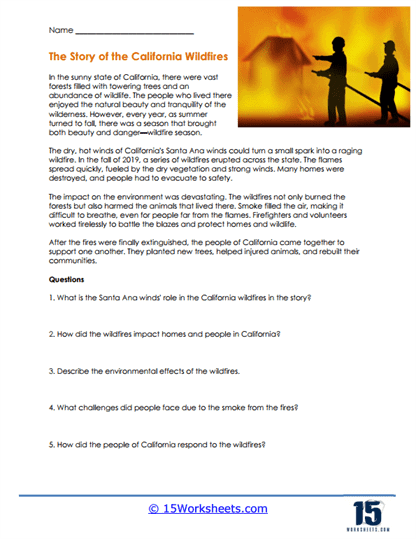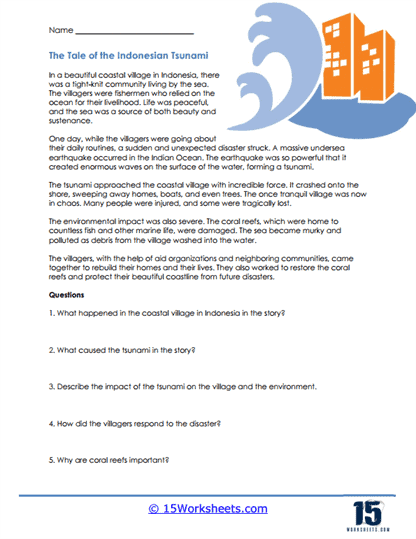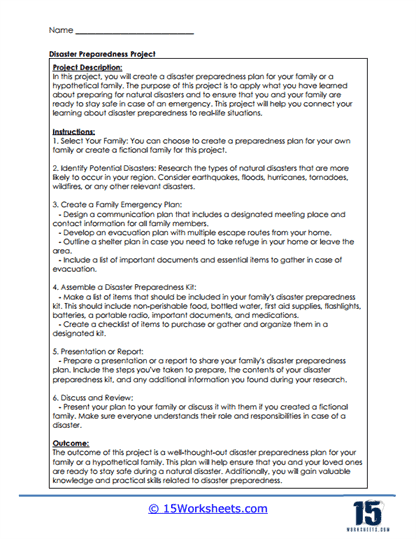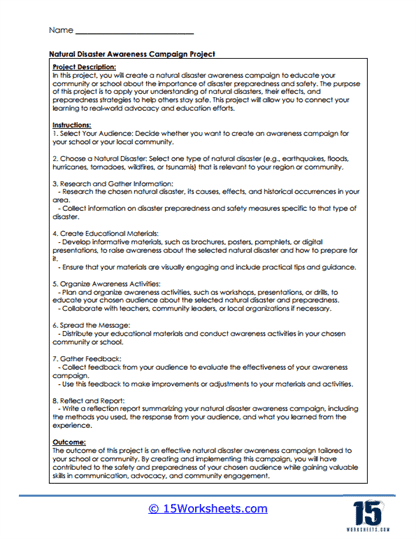Natural Disasters Worksheets
About These 15 Worksheets
In today’s rapidly changing world, where natural disasters are occurring with increasing frequency and intensity, it has never been more critical to educate young minds about the complexities of these events. The collection of worksheets on natural disasters serves as an invaluable tool in fostering awareness, encouraging critical thinking, and equipping students with the essential knowledge to navigate the challenges posed by such calamities. By immersing themselves in these thoughtfully designed materials, students gain a much-needed understanding of the scientific, environmental, and societal aspects of natural disasters, preparing them not just for academic success but for life as responsible and informed global citizens.
One of the most significant contributions of these worksheets is their ability to raise awareness about the growing prevalence of natural disasters, a trend that is inextricably linked to climate change. With rising global temperatures, shifting weather patterns, and other environmental changes, events like hurricanes, wildfires, and floods are becoming more severe and more frequent. As students work through these exercises, they begin to grasp not only the scientific principles behind these events but also the broader environmental factors that are exacerbating them. This awareness is key to helping students understand the urgency of the situation and the role they can play in mitigating future impacts.
The structure of these worksheets is designed to engage students through diverse and interactive exercises. By exploring a variety of natural disasters-from earthquakes and tsunamis to volcanic eruptions and tornadoes-students are exposed to a wide range of scenarios that require different forms of analysis and understanding. This multifaceted approach ensures that students do not just memorize facts but engage deeply with the material, drawing connections between the natural world and human society. They come away with a more holistic understanding of how natural disasters affect not only the physical environment but also the communities, economies, and cultures that depend on it.
These worksheets go beyond simply explaining natural disasters; they encourage students to think critically about the information presented. Each worksheet begins with a comprehensive explanation of a particular disaster, followed by questions designed to challenge students to think beyond the surface. They are asked to analyze the causes and effects of different events, make inferences based on the data provided, and apply their knowledge to real-world scenarios. This critical thinking component is essential, as it helps students develop problem-solving skills that they can carry with them throughout their lives.
A significant focus of the worksheets is on scientific literacy, which is critical in today’s data-driven world. Through clear explanations and engaging activities, students learn to understand natural phenomena through the lens of scientific principles. They begin to see how processes like tectonic plate movement or atmospheric pressure influence the occurrence of disasters like earthquakes and hurricanes. This reinforces their ability to connect natural events with scientific causes and effects, building a strong foundation in science that is crucial for their overall academic development.
In addition to fostering scientific literacy, these worksheets emphasize the importance of preparedness and problem-solving. Many of the exercises focus on practical skills, particularly those related to safety and community resilience during disasters. For example, students might be tasked with creating an emergency preparedness plan for a hypothetical natural disaster or assessing the vulnerability of certain regions to specific types of events. These exercises not only help students develop valuable life skills but also instill a sense of personal responsibility in the face of natural hazards. By understanding the steps they can take to protect themselves and their communities, students become more resilient in the face of an increasingly unpredictable world.
Geographical awareness is another critical skill developed through these materials. By studying how different regions of the world are prone to certain types of natural disasters, students gain a deeper understanding of global patterns and trends. For instance, they might learn why some countries are more susceptible to earthquakes while others face a higher risk of hurricanes. This geographic literacy is essential for students to appreciate the interconnectedness of our world and the shared responsibility we all have in addressing global challenges like climate change and disaster preparedness.
Types of Exercises
Multiple Choice Questions (MCQs) – These assess students’ basic comprehension of topics.
Example: Which of the following can be caused by underwater earthquakes? (A) Tornado (B) Tsunami (C) Drought (D) Blizzard.
True or False – Used to dispel myths or misconceptions and to confirm students’ foundational knowledge.
Example: “Hurricanes and typhoons are the same type of natural disaster.” (True/False)
Fill in the Blanks – Pushes students to recall facts or terms related to natural disasters.
Example: “An extended period of deficient rainfall relative to the statistical multi-year average is called _______.”
Matching Exercises – These can be used to connect natural disaster terms to their definitions or effects.
Example: Match the natural disaster (Earthquake, Flood, Volcano) with its description or impact.
Diagram Labeling – Visual exercises that might include maps or diagrams of tectonic plates, cyclone formation, etc., requiring students to label or identify key components.
Example: Label the parts of a volcano (magma chamber, vent, crater).
Short Answer Questions – Designed to test deeper understanding and analytical skills.
Example: Describe the primary differences between a tornado and a hurricane.
Case Studies – These provide real-world examples of natural disasters for students to analyze. They might be asked to identify causes, effects, or evaluate response strategies.
Example: Given a case study on the 2010 Haiti earthquake, list the primary challenges faced in the aftermath.
Scenario-Based Exercises – Students could be given a hypothetical situation and asked to develop a disaster response or evacuation plan.
Example: Imagine you’re the mayor of a town located near a dormant volcano that has suddenly become active. Outline your immediate response plan.
Common Natural Disasters
Natural disasters have plagued humanity for centuries, causing immense destruction, loss of life, and economic damage. Here are some of the most common natural disasters, along with their causes and descriptions:
Earthquakes
Earthquakes can vary in strength, from minor tremors that are barely felt to major quakes causing massive destruction. They can lead to tsunamis, landslides, and aftershocks. Caused by the sudden release of energy in the Earth’s crust, leading to seismic waves. This energy release is often the result of tectonic plates moving and interacting, such as converging, diverging, or sliding past each other.
Tsunamis
Tsunamis are giant sea waves that can travel vast distances. Upon reaching shallow waters near coastlines, these waves rise and can inundate coastal areas, causing significant loss of life and property damage. Often triggered by underwater earthquakes, but can also result from volcanic eruptions, landslides, or even meteorite impacts in the ocean.
Hurricanes, Typhoons, and Cyclones
These are intense tropical storms with strong winds, heavy rain, and storm surges. Their nomenclature varies based on their location: hurricanes (Atlantic and eastern North Pacific), typhoons (northwestern Pacific), and cyclones (south Pacific and Indian Ocean). Formed in tropical regions when warm ocean waters provide the energy and moisture needed for a low-pressure system to develop into a cyclonic storm.
Tornadoes
Tornadoes are violent, funnel-shaped wind columns that touch the ground. They have a relatively small diameter but can have incredibly high wind speeds. They can quickly devastate structures and landscapes in their path. Develop from severe thunderstorms in specific atmospheric conditions. The rotating updraft known as a mesocyclone, combined with changes in wind speed and direction with altitude (wind shear), can lead to the formation of a tornado.
Floods
Floods involve the overflowing of water onto typically dry land. They can occur suddenly (flash floods) or build up gradually. Prolonged floods can displace residents, contaminate drinking water, and damage infrastructure. Excessive rainfall, the melting of snowpacks, storm surges from cyclonic events, or the failure of dams and levees can lead to floods.
Droughts
Droughts result in a water shortage, affecting crop yields, decreasing groundwater levels, and leading to food and water scarcity. Prolonged periods of deficient rainfall relative to the statistical multi-year average.
Wildfires
Wildfires are uncontrolled fires that spread rapidly, consuming vegetation in their path. They can lead to loss of life, property damage, and significant ecological impacts. Can be ignited naturally, often by lightning, or by human activities. Dry conditions, high temperatures, and strong winds can exacerbate wildfires.
Volcanic Eruptions
This can result in the release of ash, lava, and gases. Eruptions can lead to lahars (mudflows), pyroclastic flows, ashfall, and even affect global climate. Occur when there’s an explosion of magma from beneath the Earth’s crust.
Landslides
Landslides involve the downward and outward movement of slope-forming materials like rock, soil, and vegetation. They can bury habitats and pose significant hazards in hilly or mountainous areas. Triggered by factors like rainfall, earthquakes, volcanic activity, or man-made disturbances.





